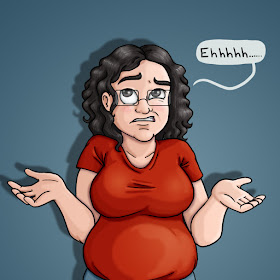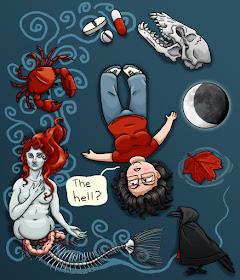Genre: Monster, Werewolf, Romance, Ghosts/Haunting,
Psychological Horror, Mystery
Audience: Adult
Diversity: Lesbian characters, trans character, mentally ill character
Takes Place in: North Eastern US
Content Warnings: Mental Illness, Self-Harm, Mentions of
Transphobia, Suicide, Emotional Abuse (Highlight to view)
The Drowning Girl is a beautifully written, psychological horror novel about a young woman, Imp, whose schizophrenia is making it difficult for her to determine the nature of the mysterious woman haunting her. Is she a siren using her charm to lure Imp to disaster? A werewolf? A human stalker who can blur the lines of reality? Imp struggles to sort out the truth before she loses herself. Queer romance, myths, and art combine to create this award winning novel.
So did I like it? Well.......
In theory I should have loved it. It takes place on my home turf of New England, the main character is a queer artist (like me!), she's dating an incredibly well written trans character, the story has a creepy mystery, gorgeous imagery, and one of the best representations of mental illness I've ever read. But I struggled to get through the Drowning Girl. I'd pick it up, read a chapter, and then forget about it for a month. I don't know why I didn't devour this book as quickly as I do others, there wasn't really anything I disliked about it, and it wasn't boring, but it just didn't seem to capture my attention. It reminded me of one of those award winning art films that critics love and you have to sit through in college film classes. There's nothing bad about it per se, but you'd still rather be watching Bad Boys II, or some other equally ridiculous action flick.
Maybe I'm just not sophisticated enough to appreciate the non-linear, stream of conciseness (i.e. all over the place) writing, or perhaps I'm too clueless to fully comprehend the subtly and symbolism of the story. But I found it really jarring to have Imp describe her girlfriend, Abalyn, play Kingdom Hearts one minute, and then have a poetic, jumbled passage full of fairy tale metaphors the next. And I get it, the writing style is intended to represent Imp's mental illness by showing the disorganization of her thought process, the random associations she makes where none exist, and her difficulty remembering what's real and what's imagined. But that doesn't always make for an enjoyable read.
I guess I'm just incredibly picky when it comes to "artsy" prose and magical realism. When it works, it works well, but when it doesn't, it just becomes a confusing, irritating erratic mess, and with the Drowning Girl it was kind of a crap shoot.
So did I like it? Well.......
Sort of?
In theory I should have loved it. It takes place on my home turf of New England, the main character is a queer artist (like me!), she's dating an incredibly well written trans character, the story has a creepy mystery, gorgeous imagery, and one of the best representations of mental illness I've ever read. But I struggled to get through the Drowning Girl. I'd pick it up, read a chapter, and then forget about it for a month. I don't know why I didn't devour this book as quickly as I do others, there wasn't really anything I disliked about it, and it wasn't boring, but it just didn't seem to capture my attention. It reminded me of one of those award winning art films that critics love and you have to sit through in college film classes. There's nothing bad about it per se, but you'd still rather be watching Bad Boys II, or some other equally ridiculous action flick.
Ugh, I should've just watched Sharknado again
Maybe I'm just not sophisticated enough to appreciate the non-linear, stream of conciseness (i.e. all over the place) writing, or perhaps I'm too clueless to fully comprehend the subtly and symbolism of the story. But I found it really jarring to have Imp describe her girlfriend, Abalyn, play Kingdom Hearts one minute, and then have a poetic, jumbled passage full of fairy tale metaphors the next. And I get it, the writing style is intended to represent Imp's mental illness by showing the disorganization of her thought process, the random associations she makes where none exist, and her difficulty remembering what's real and what's imagined. But that doesn't always make for an enjoyable read.
I guess I'm just incredibly picky when it comes to "artsy" prose and magical realism. When it works, it works well, but when it doesn't, it just becomes a confusing, irritating erratic mess, and with the Drowning Girl it was kind of a crap shoot.
WTF is going on? Did I take expired cold medicine again?
Since I'm starting to feel bad for picking on this book so much (and it's by no means a bad book), I want to address one of the things I did really like about the story, how Imp's mental illness was treated. It
wasn't romanticized, it was just a part of her that could make
her life more challenging, but not horrible. Medication made her illness manageable, but
didn't make it disappear entirely, and she was able to continue working, date, hang out with friends, pursue hobbies, and lived on her own. She would go through rough patches, some she could handle on her own, and some she couldn't. Her therapist was supportive, without telling Imp what to do. Overall, I felt like it was a very realistic
depiction of a woman with a mental illness, which is rather uncommon in fiction
where the mentally ill are usually written as either asylum inmates, criminals, or
manic pixie dream girls.Overall, I really, really wanted to love this one. It had all the right ingredients, rave reviews, a talented author, but the final result was disappointing, at least for me. It wasn't bad, but I just couldn't bring myself to give it a "highly recommended". That doesn't mean other people won't find this book amazing, and I strongly encourage others, especially those with more sophisticated taste than mine, to give it a read. Because you may love it. Or you may find it "meh", but at least you won't regret reading it.











